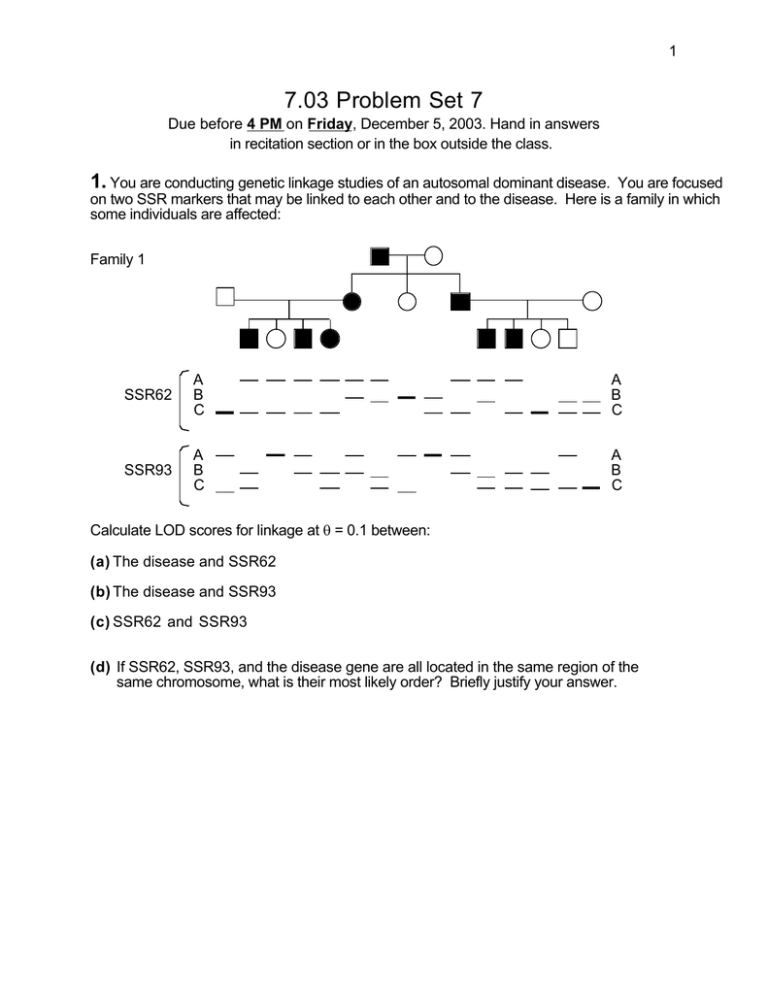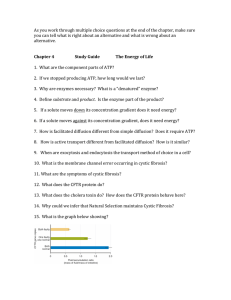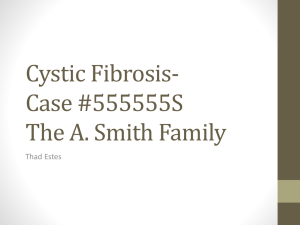7.03 Problem Set 7 1.
advertisement

1 7.03 Problem Set 7 Due before 4 PM on Friday, December 5, 2003. Hand in answers in recitation section or in the box outside the class. 1. You are conducting genetic linkage studies of an autosomal dominant disease. You are focused on two SSR markers that may be linked to each other and to the disease. Here is a family in which some individuals are affected: Family 1 SSR62 A B C A B C SSR93 A B C A B C Calculate LOD scores for linkage at θ = 0.1 between: (a) The disease and SSR62 (b) The disease and SSR93 (c) SSR62 and SSR93 (d) If SSR62, SSR93, and the disease gene are all located in the same region of the same chromosome, what is their most likely order? Briefly justify your answer. 2 2. You are running a human assisted reproduction clinic and providing state-of-the-art genetic diagnostic services. A married couple who already had a child with cystic fibrosis approach you because they wish to have another child, but only if they can be assured that the child will not have cystic fibrosis. You genotype the woman and discover that she is a heterozygote for Del508, the most common mutation causing cystic fibrosis. You suggest that the couple consider first polar body testing, in which several unfertilized oocytes (each with its first polar body) are retrieved from the woman, the first polar bodies are removed, and PCR tests are conducted on DNA from each of the first polar bodies. The couple agrees, and you obtain the following results: PCR test of first polar body DNA for presence of Oocyte Del508 wild-type sequence #1 + + #2 + - #3 + - #4 - + #5 + + #6 - + (a) Propose an explanation for the observation that the polar bodies for oocytes #1 and #5 test positive for both Del508 and the wild type sequence, while the polar bodies for the other oocytes do not. (Do not appeal to nondisjunction.) Illustrate your explanation with a sketch of meiosis in oocyte #1. (b) Given the couple's desire to have a child without cystic fibrosis, which oocytes would you employ in vitro fertilization? Briefly explain or illustrate your answer. (c) Which additional oocytes would you consider fertilizing if you could then 1) retrieve the second polar body for PCR testing and 2) selectively return “unaffected” embryos to the woman’s uterus? Briefly explain or illustrate your answer. (d) The cystic fibrosis gene is located on human chromosome 7. Would polymorphisms within the cystic fibrosis gene be suitable for use in determining the parental origin of the extra chromosome in cases of trisomy 7? Would they be suitable for use in determining whether nondisjunction had occurred in Meiosis I or Meiosis II? Briefly justify your answers.



